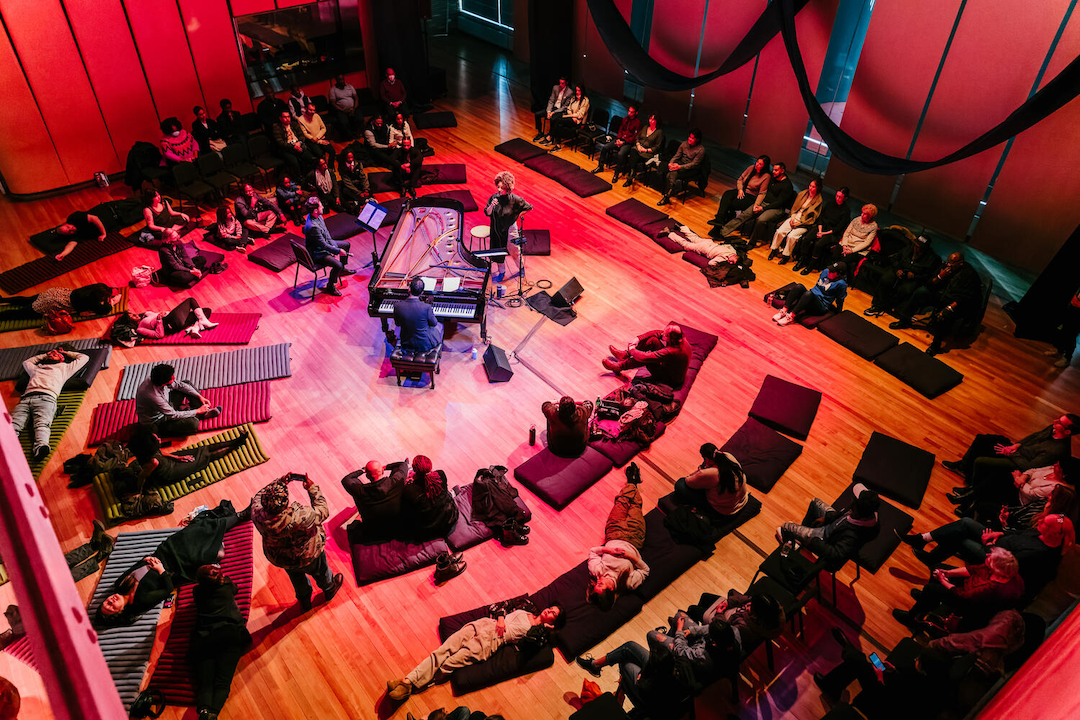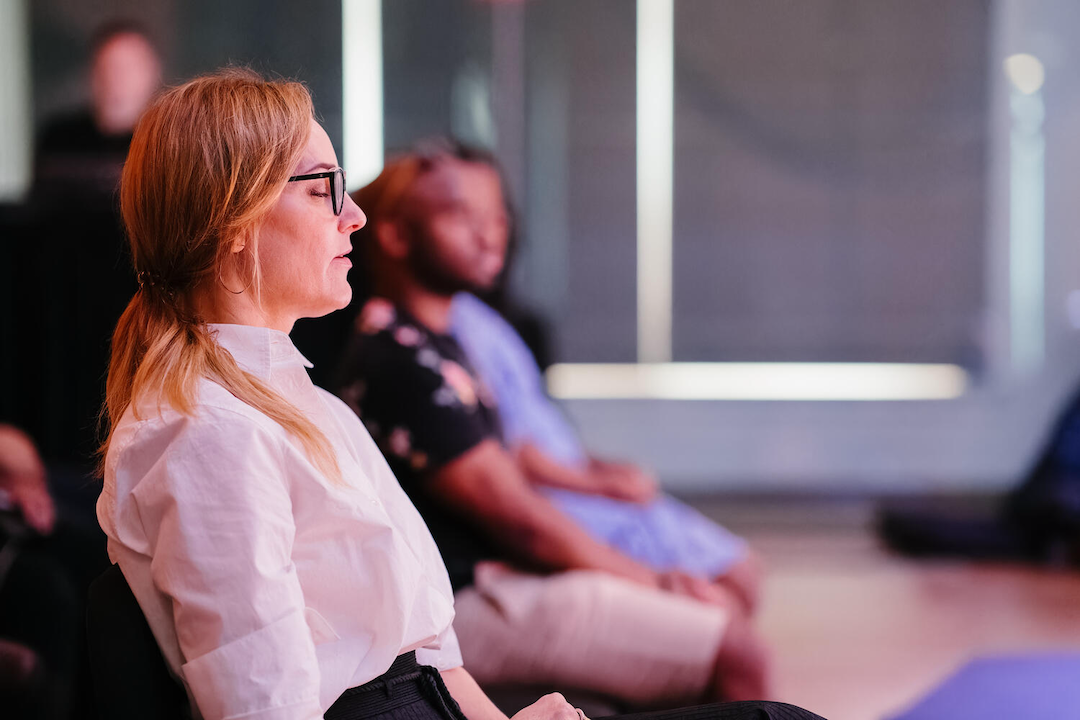A Carnegie Hall concert series designed for mental health

Fadi Kheir
A Carnegie Hall concert series designed for mental health
Singer performs at Carnegie Hall well-being concert
Imagine you go to a concert at the esteemed Carnegie Hall in New York. Instead of sitting in a chair, you are invited to make yourself comfortable on soft floor cushions or a yoga mat. Rather than being shushed, you are encouraged to connect with your neighbor. And at the moment when the first musical notes would normally sound, a host invites you to breathe in and out mindfully. Even the lighting is softer and warmer.
“We hung fabric to make the space more inviting and cozy,” says Sarah Johnson, director of Carnegie Hall’s Weill Music Institute (WMI). “Given everything that people are navigating in today’s world, we wanted to intentionally craft a communal musical experience to maximize the health benefits of attending a performance.”
Premiering earlier this month, Carnegie Hall’s ongoing series of 16 Well-Being Concerts isn’t only designed to entertain — it aims to deliver tangible health benefits. According to a sweeping 2019 World Health Organization report, making and listening to music is associated with reduced stress, anxiety, and loneliness.
Reasons to Be Cheerful looks at how this legendary New York theater is using culture to cultivate well-being.
The report — along with findings that a significant percentage of Americans who suffer from anxiety and depression don’t receive adequate care — inspired the series of performances. Some are open to the general public, while others are curated for specific audiences such as health care workers, veterans, or people impacted by the justice system.
“We started to wonder, what could we do?” Johnson says of the series’ genesis. “How could we create an opportunity for people to maximize the potential well-being impact of a live musical experience?”
![]()

Fadi Kheir
‘We’re trying to really hold the space for the audience to have as fruitful of an experience as possible during the concert.’
Carnegie Hall well-being concert
When vocalist Sarah Elizabeth Charles starts singing the first tunes of “Conscious Mind,” some listeners close their eyes to focus on her crystal clear, soulful voice. “Love the world” is the refrain. Charles and her husband, pianist Jarrett Cherner, finished writing their album Tone during the pandemic. “Trying to cultivate loving kindness and mindfulness during these trying times,” Charles remembers. “And then sharing that loving kindness outward into the world. We could never have known at the time how well it would fit into this space now.”
Both the artists and the attendees say they experience the Well-Being Concerts quite differently from your typical performance. Instead of watching the artists on an elevated stage, the attendees are on the same level and form a circle around the performers. “It feels much more connected,” is how Charles describes the difference. “We’re trying to really hold the space for the audience to have as fruitful of an experience as possible during the concert. It’s a really cool way to dig into the meaning of the content.”
Carnegie Hall piloted the Well-Being Concerts this spring mainly for health care providers and people impacted by the justice system. The response was so enthusiastic that the Weill Institute expanded the series for this season.
It hosted the first Well-Being Concert of this season on November 11 for health care workers at New York City’s public hospitals, because of the “acute challenge for the health care world in the last few years,” Johnson explains. “We’ve all been so fragmented and pulled in a million directions, the events are meant to offer relief.” The audience was capped at 100 people to create a sense of intimacy.
Both Johnson and strategic advisor Ian Koebner take care not to stigmatize or exclude any attendees. “We take an expansive approach because we’re all swimming in very stressful, isolating waters, and we can all stand to be supported more deeply,” says Koebner, who also hosted the first Well-Being Concert. At the beginning, he invites the audience to breathe mindfully and introduces a very simple form of mindfulness meditation, though he avoids using the word meditation so as to not feed into any preconceived notions.
“As soon as I walked into the room, I felt my heart rate going down,” one attendee noted after a performance. “I felt my breathing coming back. And it just continued throughout the event…When I left, there out on the street, everything was a bit brighter and calmer and nicer.”
One nurse said after the event, “I wasn’t aware it was possible to be in a space that felt so peaceful in this city.”

Fadi Kheir
Being here and now
Listeners benefit from Carnegie Hall well-being concert
Carnegie’s series isn’t the first to address mental health through performance. The United Kingdom pioneered a program called Arts on Prescription as psychosocial support for patients experiencing loneliness or social isolation. The program has run for more than two decades and shows benefits for mental health, chronic pain and the management of acute and chronic illnesses.
“Arts in general, and music in particular, can be very therapeutic,” Koebner says. “Reflective group listening in a concert setting can have a positive physiological, psychological and social impact. For instance, the stress hormone cortisol decreases. Researchers have measured a decrease in anxiety and depression.”
Koebner worked for ten years in arts-based conflict resolution before joining Carnegie Hall. A licensed acupuncturist, he has a PhD in healthcare leadership from UC Davis, where he was also the director of integrative pain medicine. This career path led him to wanting to “be a partner in addressing the burden of chronic pain and loneliness.” He quotes studies that found listening to music can “reduce symptoms of depression, increase well-being through the creation of social connection and provide an important resource for self-development, recovery and quality of life among individuals with long-term illnesses.”
The concert series is “an artistic exploration as well as a laboratory,” according to Koebner. Its impact will be evaluated in cooperation with The Berkeley Social Interaction Lab at UC Berkeley. Under the guidance of psychology professor Dacher Keltner, the researchers study the experience of live concerts with a randomized controlled trial about the impact of the season.
The Weill Music Institute at Carnegie Hall has more than 14 years of experience with presenting concerts in diverse and often high-stress public spaces, including hospitals, senior care residences and schools, as well as with people experiencing homelessness. “We want to think about how to support well-being concerts outside of the very kind of rarefied air of Carnegie Hall,” Koebner says.
For instance, the WMI has been offering a program called Musical Connections in maximum-security correctional facilities like Sing Sing. Sarah Elizabeth Charles has served as a vocal coach for women at New York’s jail on Rikers Island as part of the Weill Institute’s Lullaby Project, writing lullabies with and for young mothers. Charles calls the experience of bringing her music into prisons “life-changing.” The Lullaby Project explores what role music can play in mitigating stress for expecting families and new parents, proving that music “can spur language development and moderate stress.” It also helped Charles work through her own miscarriage and pregnancy.
“The programs have an effect on us as well,” Johnson says. “I found the concert really helpful to me personally. It was quite peaceful, lovely and contemplative. We who do this work are changed by it, too. With this work, there is the potential for 360 degrees of impact.”
The response to the first Well-Being Concerts has been encouraging, but the organizers know that mental health challenges are rarely resolved with one performance.
“The concert felt very healing,” one attendee said after one of the pilot concerts in spring. “But I’m very aware that I am now going back out onto the streets of Gotham.”
Johnson’s team is looking into ways to prolong the impact. “How do you extend the impact of a single event?” Koebner asks. He is helping to create resources for the audience –– for instance, curated playlists attendees can download, and short recording snippets of the concert that he sends out for several weeks afterward to prolong the impact.
At the end of the concert, Charles and Cherner invite the audience to sing along and lead the room in lyrics that could hardly be more fitting: “Be here and now, living life out loud.”
This story was produced by Reasons to be Cheerful and reviewed and distributed by Stacker Media.
